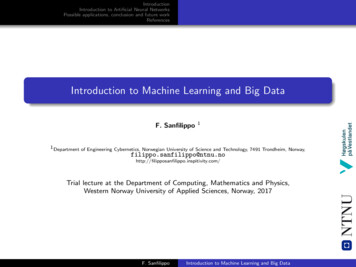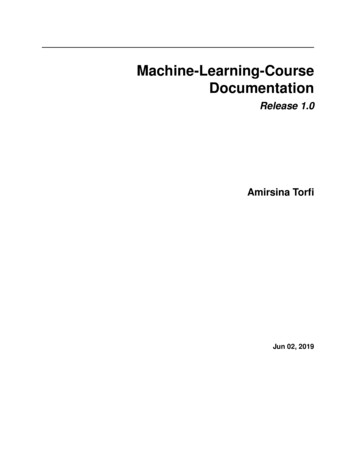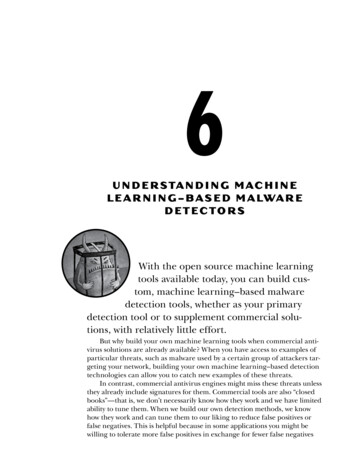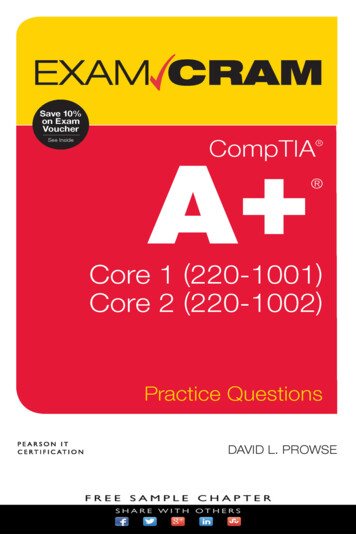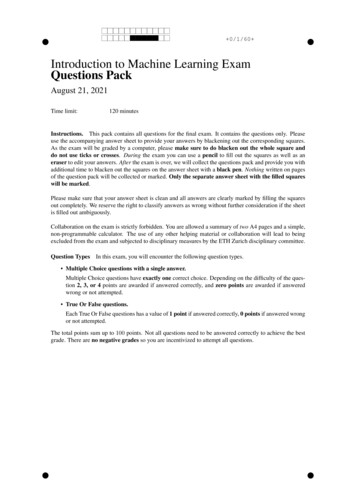
Transcription
0/1/60 Introduction to Machine Learning ExamQuestions PackAugust 21, 2021Time limit:120 minutesInstructions. This pack contains all questions for the final exam. It contains the questions only. Pleaseuse the accompanying answer sheet to provide your answers by blackening out the corresponding squares.As the exam will be graded by a computer, please make sure to do blacken out the whole square anddo not use ticks or crosses. During the exam you can use a pencil to fill out the squares as well as aneraser to edit your answers. After the exam is over, we will collect the questions pack and provide you withadditional time to blacken out the squares on the answer sheet with a black pen. Nothing written on pagesof the question pack will be collected or marked. Only the separate answer sheet with the filled squareswill be marked.Please make sure that your answer sheet is clean and all answers are clearly marked by filling the squaresout completely. We reserve the right to classify answers as wrong without further consideration if the sheetis filled out ambiguously.Collaboration on the exam is strictly forbidden. You are allowed a summary of two A4 pages and a simple,non-programmable calculator. The use of any other helping material or collaboration will lead to beingexcluded from the exam and subjected to disciplinary measures by the ETH Zurich disciplinary committee.Question Types In this exam, you will encounter the following question types. Multiple Choice questions with a single answer.Multiple Choice questions have exactly one correct choice. Depending on the difficulty of the question 2, 3, or 4 points are awarded if answered correctly, and zero points are awarded if answeredwrong or not attempted. True Or False questions.Each True Or False questions has a value of 1 point if answered correctly, 0 points if answered wrongor not attempted.The total points sum up to 100 points. Not all questions need to be answered correctly to achieve the bestgrade. There are no negative grades so you are incentivized to attempt all questions.
1/1/59 1Regression, Classification and Other LossesWe are given a dataset consisting of n labeled training points D {(x1 , y1 ), ., (xn , yn )}, where xi 2 Rdare the feature vectors and yi 2 R are the labels. The design matrix X 2 Rn d contains as rows the featurevectors xi 2 Rd . The label vector is denoted by y (y1 , . . . , yn ) 2 Rn . We assume that X is full ranki.e., rank(X) min(n, d). The empirical risk with the squared loss is defined as follows:nR̂D (w) 1X (w xin i 1yi ) 2 1kynXwk22 .(1)The goal is to to find w 2 Rd that minimizes the empirical risk.1.1Ordinary Least SquaresQuestion 1 (1 point) R̂D (w) is a convex function in w.ATrueBFalseQuestion 2 (1 point) When n d there always exists w such that kyATrueBXwk2 0.FalseQuestion 3 (3 points) We would like to minimize the empirical risk using stochastic gradient descent (withreplacement). At time step t, what is the update formula?A wt 1 wt t (X XwtB wt 1 wt t (2X XwtC wt 1 wt t (2XwtD wt 1 wt t (XwtE wt 1 wt t (2yiF wt 1 wt t (2yiG wt 1 wt t (yiH wt 1 wt2X y). t (2yi2X y).2XX y) .2XX y).2wt xi )xi , for some randomly chosen i 2 {1, 2, . . . , n}.2wt xi )xi , for some randomly chosen i 2 {1, 2, . . . , n}.2wt xi )xi , for some randomly chosen i 2 {1, 2, . . . , n} .wt xi )xi , for some randomly chosen i 2 {1, 2, . . . , n}.Are the following statements True or False?Question 4 (1 point) At each iteration t of the gradient descent algorithm, there exists a learning rate t 0 such that the objective decreases (either strictly decreases or stays the same).ATrueBFalseQuestion 5 (1 point) At each iteration t of the stochastic gradient descent algorithm, there exists alearning rate t 0 such that the objective decreases (either strictly decreases or stays the same).ATrueBFalse
1/2/58 1.2Model EvaluationAssume that you have access to a dataset D {(x1 , y1 ), ., (xn , yn )} of n 10000 data samples (xi , yi )that are drawn i.i.d. (indpendently and identically distributed) from some (unknown) distribution p(x, y).You now need to decide how to split this dataset into a training set Dtrain and a validation set Dval so thatyou can run the following standard procedure to learn and evaluate a regression model:Step 1: Training the regression model on Dtrain by minimizing the empirical risk01X1bDfbDtrain arg min @R(yi f (xi ))2 A .train (f ) ,f Dtrain (2)(xi ,yi )2DtrainStep 2: Estimating the true (population) risk of the learned model R(fbDtrain ) by computing the empiricalrisk on Dval defined as X1bDRfbDtrain (yi fbDtrain (xi ))2 .(3)val Dval (xi ,yi )2DvalRemember that for a fixed estimator f (x), the true (population) risk is defined as:R(f ) E(x,y) p [(yf (x))2 ].Are the following statements True or False? bDbDQuestion 6 (1 point) Rfis more likely to provide better a estimate of the true (population)trainval risk R fbDtrain , when using a validation set of size 500 as opposed to a validation set of size 1000.ATrueBFalsebQuestion 7 (1 point) Choosing a trainingset of size 1000 is more likely to provide a model fDtrain thathas a lower true (population) risk R fbDtrain compared to training set of size 2000.ATrueBFalseQuestion 8 (1 point) The training risk (error) is always less than or equal to the validation risk (error), i.e., bDbDR(fbDtrain ) RfbDtrain .trainvalATrueBFalseQuestion 9 (1 point) The validation risk in Equation (3) is an unbiased estimator of the true (population)risk i.e.,h ihibDED RfbDtrain ED R(fbDtrain ) .valATrueBFalse
1/3/57 1.3ClassificationQuestion 10 (3 points) The table below shows the confusion matrix for a classifier f on the Iris dataset, adataset consisting of three different types of flowers as labels.Actual ClassPredicted rginica20051050520040From the table, we derive a new binary classifier fbinary that predicts "Virginica" (label y 1) when fdoes and "not Virginica" (label y 1) when f predicts "Versicolour" or "Setosa". What is the falsediscovery rate (FDR) of fbinary ?#FPReminder: FDR #FP #TPwhere #FP is the number of false positives and #TP is the number of truepositives.AB13C15D14E12F1935HG 025Question 11 (3 points) A classifier f : X ! { 1, 1} is called a random classifier, if it assigns anyx 2 X independently to class f (x) yb 1 with probability and to class f (x) yb 1 withprobability 1 for some 0 1. Taking the perspective of hypothesis testing, we call samples withpredicted class yb 1 positives and class yb 1 negatives. Assume that the distribution of the datasatisfies P (x, y). We can compute the false positive rate FPR P (by 1 y 1) and false negative rateFNR P (by 1 y 1) of random classifiers for different . What is the smallest FNR that you canobtain with a random classifier with FPR 0.25 by tuning ?A0B18C14DE38F12G5834H1Question 12 (4 points) Assume that we are training a binary classifier y f (x) that is allowed to abstain,i.e., refrain from making a prediction. Therefore, we include an abstention label r as part of its action(label) space, that is f : X ! { 1, 1, r}. In order to ensure that the classifier does not always abstain,we introduce a cost c 0 for every abstention that the classifier makes. Given a labeled data sample (x, y),the 0-1 loss with abstention is then given by (f (x), y) f (x)6 y f (x)6 r cf (x) r .For a given data distribution P (x, y) and a fixed classifier f , the conditional expectation of the 0-1 lossgiven x, i.e., E[ (f (x), y) x], can then be written as:A P (y 1 x)B P (y 1 x)C P (y 1 x)D P (y 1 x)E P (y 1 x)F P (y 1 x)f (x) 1 f (x) 1 cf (x) r .f (x) 1 (1P (y 1 x))f (x) 1 cf (x) r .f (x) 1 (1P (y 1 x))f (x) 1 cf (x) r .f (x) 1 (1P (y 1 x))f (x) 1 (1c)f (x) r .f (x) 1 (1P (y 1 x))f (x) 1 (1c)f (x) r .f (x) 1 f (x) 1 (1c)f (x) r .
1/4/56 1.4Huber LossConsider the so-called Huber loss H, : R ! R for a fixed constant 0, defined as follows:(1 2aif a H, (a) : 2,( a 12 ) if a and represented in the following Figure 1.Figure 1: Plots of the abs , sq and Huber H, (with 1) loss functions.This loss is often employed to obtain estimators that are more robust to outliers in the training set. Furthermore, we denote as abs (a) : a and sq (a) : 12 a2 the absolute value and squared losses, respectively.Are the following statements True or False?Question 13 (1 point) For large values of a , the Huber loss roughly behaves like the abs loss, in the H, (a)sense that lim a ! 1 abs(a) evaluates to a finite constant.ATrueBFalseQuestion 14 (1 point) Consider running regression on a dataset {(xi , yi )}ni 1 with the Huber loss for alinear model to obtainnXŵ : arg min H, yi w xi .w2Rdi 1We expect the solution vector ŵ to be sparse, thus we can use the Huber loss for feature selection.ATrueQuestion 15 (1 point) For any fixed value ofABFalse 0, the Huber loss is convex on R.TrueBFalse
1/5/55 2KernelsQuestion 16 (2 points) This question is regarding the task of regression. We want to compare using a fullyconnected neural network vs. using kernel regression. Which of the following statements is correct?A For any choice of kernel, kernel regression methods implicitly operate on finite-dimensional featurespaces defined by the corresponding feature map.B When using a fully connected neural network, we can arrive at a closed-form solution.C Kernel regression can be considered as a linear model on an implicit feature space characterized bythe kernel’s feature map.D Regardless of the kernel we use, kernel regression can only learn a polynomial function.Figure 2: Dataset with two classes.Question 17 (4 points) Consider the dataset in Figure 2. Which of the following feature maps : R2 ! Rmakes the classes linearly separable?Reminder: The classes are linearly separable if there exists a threshold 0 2 R such (x) 0 for pointsx from the first class, and (x) 0 for points x from the second class.ApE(x) F(x) x1 x2 x1 x22G(x) x1x1x21 x22H(x) p(x) (x1 x2 )2B(x) (x1 x2 1)C(x) px12x2D(x) p2x21 x22x2x1x21 x22
1/6/54 Question 18 (3 points) Let d 2 N be a fixed constant number. Let h(m) : N ! N denote the number ofpossible monomials (terms) of degree less or equal to m over d different variables x (x1 , . . . , xd ). As anexample for d 2, m 2, the number of all the possible monomials is 6: 1, x1 , x2 , x21 , x22 , x1 x2 . What isthe growth rate of h(m)?A h(m) 2 (m).B h(m) 2 (m2 ).D h(m) 2 (md ).C h(m) 2 (dm ).Question 19 (3 points) Let d 2 N be a fixed constant number. Assume that multiplication of two numbers,addition of two numbers, and exponentiation of a number by another number (xy ) all have a constant( (1)) computational cost. What is the computational cost of constructing the kernel matrix for a datasetD {xi }ni 1 with n points xi 2 Rd using the polynomial kernel for degree-m polynomials (we use thekernel k(x, x0 ) (1 x x0 )m )?A (m)B (ndm )D (md )C (nm)E (n2 )F (mn2 )Are the following statements True or False?Question 20 (1 point) For every valid kernel k(x, x0 ) : X X ! R there exists a finite dimensionalfeature map : X ! Rd , such that k(x, x0 ) (x) (x0 ).ABTrueFalseQuestion 21 (1 point) For x, x0 2 R \ {0} we define k(x, x0 ) ABTruesin(x)(x0 )2 1. k is a valid kernel.FalseQuestion 22 (1 point) For x, x 2 R we define k(x, x ) x M x with M 002ATrue B0 122. k is a valid kernel.1FalseQuestion 23 (1 point) Let k1 be a valid kernel. Then, for any polynomial function f , k (x, x0 ) f (k1 (x, x0 )) is a valid kernel.ATrueBFalse
1/7/53 3Dimensionality Reduction with PCAIn principal component analysis (PCA), we map the data points xi 2 Rd , i 1, . . . , n, to zi 2 Rk , k d,by solving the following optimization problem:C We denote bynPi.e.,xi 0.W , z1 , . . . , zn nX1minkW zin W 2Rd k ,W W I i 1z1 ,.,zn 2R2(4)xi k2 .kthe optimal solution of Equation (4). Assume the data points are centered,i 1Question 24 (3 points) What is the value of Tr(W W )?Reminder: For a square matrix A 2 Rk k we denote its trace by Tr(A) and it is defined as the sum of itsPkdiagonal elements: Tr(A) i 1 AiiA nB kD max(n, d)C dQuestion 25 (3 points) What holds for zi ?C zi (W W ) 1 W xiD zi W (W W ) 1 W xiA zi W (W W ) 1 xiB zi (W W ) 1 W xiQuestionLet 1···0 be the eigenvalues of the empirical covariance matrix2dPn26 (4 points) d d n1 i 1 xi x . Let v1 , . . . , vd 2 Rd be the corresponding eigenvectors. Remember that:i 2RW zi (kXvj vj )xi .j 1What is the value of C ?Hint: (i.) kxk22 x x Tr(x x), 8x 2 Rd , (ii.) Tr(ABC) Tr(CAB) Tr(BCA) for matricesA, B, C of appropriate dimensions. For a definition of trace, see the reminder in Question 24.PPPPB n1 ki 1 iD n1 ki 1 2iC n1 di k 1 2iA n1 di k 1 iAre the following statements True or False?Question 27 (1 point) PCA helps us find a linear mapping to a lower dimensional space.ATrueBFalseQuestion 28 (1 point) Let n be the number of the points and d the dimension of the points in the dataset.In standard PCA, we compute the spectral decomposition (eigenvalues and eigenvectors) of the empiricalcovariance matrix with size d d. In kernelized PCA we instead compute the spectral decomposition of amatrix of size n n.ATrueBFalseQuestion 29 (1 point) Imagine two features are identical in the whole dataset, i.e., they are identical amongall data samples x1 , . . . , , xn . Then, utilizing PCA, we can strictly reduce the dimension of the dataset byat least one with zero reconstruction error.ATrueBFalse
1/8/52 44.1Neural Networks and OptimizationRegression with Neural NetworksWe model a regression problem on the dataset {(xi , yi )}i 1,.,n , where inputs xi and labels yi are both inRd , with a fully connected neural network. We use the sigmoid activation function '(x) , 1 e1 x . Thesigmoid function is applied element-wise to vectors.Therefore, the whole neural network is a function f : Rd ! Rd , f (x) W3 '(W2 '(W1 x b1 ) b2 ) b3 ,where Wj 2 Rd d , bj 2 Rd , j 2 {1, 2, 3}. Here, we have dropped the dependence of f (x) on Wj , bj forsimplicity, and f is written only as a function of the input x to the neural network.Suppose that during training, we only optimize parameters W3 , b3 , while keeping the other parametersfixed. That is, we would like to solveminW3 ,b3nXi 12kf (xi )yi k2 .(5)Answer the following questions.Question 30 (1 point) The objective from Equation (5) is convex with respect to W3 , b3 .ATrueBFalseQuestion 31 (1 point) We are using the cross-entropy loss function in the objective in Equation (5).ATrueBFalseQuestion 32 (3 points) Assume that d 1. We pass a batch of input samples {xi }i2S defined by anindex set S {1, . . . , n} through a batch normalization layer with scale and shift parameters 2, 0respectively. For every input xi , the layer outputs x̄i xi SµS , where µS and S are the empiricalmean and standard deviation of the input batch. What are the empirical mean and standard deviation of{x̄i }i2S ? µSSA (µS , S )E (0, 1)G (0, 2)C S , S µSSD S , 2 S B (µS , 2 S )F (4, 1)H (4, 2)
1/9/51 4.2Training Neural NetworksConsider training a multilayer perceptron (a fully connected neural network) using gradient descent.Answer the following questions.Question 33 (1 point) The network weights are updated during forward propagation.ATrueBFalseQuestion 34 (1 point) For performing a binary classification task, the final output of the neural network istypically passed through a ReLu activation before being compared to the label.ATrueBFalseQuestion 35 (2 points) Below are the (smoothed) training loss curves for 3 small identical networks trainedwith the following optimization algorithms:A Gradient descent.B Batch stochastic gradient descent with large batch size.C Batch stochastic gradient descent with small batch size.We use the same constant learning rate in all 3 cases. The x-axis corresponds to the batch size multipliedby number of (stochastic) gradient descent iterations. Match the images (left to right) with the optimizationmethod used.A (A, B, C)B (A, C, B)C (B, A, C)D (B, C, A)E (C, A, B)F (C, B, A)Question 36 (3 points)We have a one-layer fully connected neural network with input nodes vi , i 1, . . . , d, and a single outputnode vout . The activation function of the output node vout is the identity. We initialize every weight independently with a standard Gaussian distribution wi N 0, 2 , i 2 {1, . . . , d}. To avoid overfitting, weuse dropout and thus independently set each node vj to zero with probability 1 p.Assume we give as input to the network d independent random variables Xi , i 1, . . . , d, with E[Xi ] 20, E[Xi2 ] 1. How should we choose the variance 2 so that we have E[vout ] 0 and E[vout] 1? Herethe randomness is over the random variables Xi , weights wi , and node dropout events.A2 2dp(1 p)B2 2dpC2 1dpD2 1dp(1 p)
1/10/50 Question 37 (2 points) Figure 3 displays a training dataset and the learned function of 3 different neuralnetworks that are trained on the dataset. The dataset consists of 100 scalar input-output pairs. All neuralnetworks have one hidden layer with 20 units but differ in the choice of the activation function that are eitherthe sigmoid, ReLu or identity function. Match the learned output function with the activation function thatis used in the corresponding neural network.Figure 3: Effect of different activation functions.A (A, B, C) (sigmoid, ReLu, identity)B (A, B, C) (sigmoid, identity, ReLu)C (A, B, C) (ReLu, sigmoid, identity)D (A, B, C) (ReLu, identity, sigmoid)E (A, B, C) (identity, ReLu, sigmoid)F (A, B, C) (identity, sigmoid, ReLu)Question 38 (3 points) Assume the input to a convolutional layer is a 16 19 matrix and you perform aconvolution with kernel size 4 3 with padding equal to 0 and horizontal and vertical strides equal to 2.After performing the convolution, you flatten the resulting matrix to a vector. What is the dimension of theresulting vector?A 56B 58C 63D 64
1/11/49 4.3OptimizationQuestion 39 (2 points) You are using gradient descent to find the minimum of the function f (x) x2 .You experiment by fixing the number of iterations T and trying different learning rates to find the one whichleads to a better (smaller) solution. There are different possible settings, e.g., you choose a learning rate ofzero (1), the optimal learning rate (2), a learning rate that is too large (3) or too small (4).When initializing at point A on the plot below, which point of the plot are you most likely to reach witheach learning rate setting? Match the settings 1, 2, 3, and 4 to the points on the plot indicated by letters A,B, C, and D.1: learning rate of zero2: optimal learning rate3: too large learning rate4: too small learning rateABCD1:1:1:1:A, 2:A, 2:A, 2:A, 2:B, 3: C, 4: DB, 3: D, 4: CC, 3: B, 4: DD, 3: B, 4: CEFGH1:1:1:1:D, 2: A, 3: C , 4: BD, 2: A, 3: B, 4: CC, 2: D, 3: B, 4: AC, 2: B, 3: D, 4: AQuestion 40 (2 points) Now we use gradient descent with momentum to find the minimum of the functionf (x) x2 . We set both the momentum parameter m and learning rate parameter to some strictly positive(nonzero) value. At the 2020’th time step we move from x2019 6 0 to x2020 0. We perform one moreupdate to obtain x2021 . Which of the following is true?A f (x2020 ) f (x2021 )B f (x2020 ) f (x2021 )C f (x2020 ) f (x2021 )
1/12/48 5Frequentist and Bayesian InferenceQuestion 41 (2 points) What is the advantage of using bootstrap parameter estimates in comparison withdistribution-dependent parameter estimates? Choose the correct statement among the following.A It is possible to compute the closed-form solution for bootstrap parameter estimates.B Bootstrap parameter estimates require less computational resources than distribution-dependent parameter estimates.C Bootstrap parameter estimates can be computed for any black-box predictor.D Distribution-based parameter estimates have asymptotic guarantees while bootstrap estimates do not.Question 42 (2 points) Consider a dataset D {xi }ni 1 and assume that the likelihood function P (D )depends on some parameters to be estimated. Furthermore, we assume that we have access to the trueprior P ( ) over the parameters. Choose the correct statement among the following.A The maximum a posteriori (MAP) estimate and the maximum likelihood estimate (MLE) coincide,since they both involve a maximization of the likelihood P (D ).B The posterior distribution over the parameters is given by P ( D) P (D )P ( ).C Both the MLE and the MAP estimates maximize P (D ).D The maximum likelihood estimate is a point estimate, whereas the maximum a posteriori estimateoutputs a distribution.E Frequentist inference results in a point estimate for , whereas Bayesian inference naturally results ina distribution over .
1/13/47 66.1Expectation Maximization AlgorithmClustering Movies Using Soft EMWe utilize the (soft) expectation maximization (EM) algorithm for clustering movies into two clustersbased on the actors who star in them. We abbreviate each of the movies ’(S)tar Wars’, ’(T)itanic’, ’The(G)odfather’, ’(I)nterstellar’, and ’The (M)atrix’ with the first letter of their names. For simplicity, wefocus on only four important actors and we represent each movie as a binary (zero-one) feature vectorX 2 {0, 1}4 , where the i’th, i 2 {1, 2, 3, 4}, element is equal to one if the actor is in the movie and zerootherwise. Assume there are two clusters C 2 {0, 1}.Feature vectors X for each movie are independently generated in the following way: Sample a cluster from the distribution P (C). The distribution P (C) is Bernoulli with unknownparameter q, i.e.,P (C c) q1qif c 1if c 0 Xi is generated by p(Xi C) and Xi is conditionally independent of Xj given C for all i 6 j. Thismeans that the ith feature is conditionally independent of the jth feature given the cluster assignmentof the movie. The distribution p(Xi C), i 2 {1, 2, 3, 4}, is also Bernoulli with unknown parameters.Note that this gives rise to 8 unknown parameters, four for each cluster.Hint: All questions below can be solved independently of each other.Question 43 (3 points) Which of the following describes the likelihood p(X) of a single data point?P4p(Xi C 1) (1 q) i 1 p(Xi C 0)PPB (1 q) 4i 1 p(Xi C 1) q 4i 1 p(Xi C 0)QQC q 4i 1 p(Xi C 1) (1 q) 4i 1 p(Xi C 0)QQD (1 q) 4i 1 p(Xi C 1) q 4i 1 p(Xi C 0)A qP4i 1The 5 movies above have the following feature vectors, respectively, where the bracket notation is used torepresent a vector:(1, 1, 1, 0): G(0, 1, 0, 0): S(1, 0, 1, 0): T(0, 1, 1, 0): I(1, 0, 1, 0): MQuestion 44 (3 points) E-StepYou initialize p̂(X C 1) 18 , 14 , 34 , 12 and p̂(X C 0) 12 , 12 , 12 , 12 and q̂ 12 . You use thesoft expectation maximization (EM) algorithm to cluster the movies. After performing one E-step with thisinitialization, what is the assignment probability of G to cluster 1?A 0B319C316D38E58F1316G1619H 1
1/14/46 Question 45 (4 points) M-StepAssume that after one E-step, you get the following estimated assignment probability to cluster 1 for eachmovie, respectively: 14 , 13 , 13 , 23 , 34 . Now you would like to update the estimate of the parameters. You haveq̂ 3/5. The next step is an M-step. What will q̂ be after this M-step?A 0B115C25D715E815F35G1415H 1Question 46 (2 points) You decide to try hard EM instead of soft EM. You use the same initialization ofp̂ and q̂ as in Question 44. At convergence, you obtain the following clusters: cluster 0 : {I}, cluster 1:{G, S, T, M}. Suppose you instead initialized with p̂(X C 1) 12 , 12 , 12 , 12 and p̂(X C 0) 1 1 3 18 , 4 , 4 , 2 . Assume that each E-step results in a unique hard clustering. Which of the following describesthe clusterings you would expect to see after convergence?ABCDcluster 0 :cluster 0 :cluster 0 :cluster 0 :{T, M}, cluster 1: {G, S, I}{G, S, I}, cluster 1: {T, M}{I}, cluster 1: {G, S, T, M}{G, S , T, M}, cluster 1: {I}EFGHcluster 0 :cluster 0 :cluster 0 :cluster 0 :{G, I}, cluster 1: {S, T, M}{S, T, M}, cluster 1: {G, I}{}, cluster 1: {G, S, T, I, M}{G, S, T, I, M}, cluster 1: {}
1/15/45 6.2Gaussian Mixture ModelsYou have data points x1 , . . . , xn that you want to split into two clusters (y 1 or y 2). You assume aGaussian mixture model generated by a mixture of two Gaussians: N (µ1 , 1 ) and N (µ2 , 2 ). The meanvectors µi and covariance matrices i of each of the two clusters are unknown. You assume that the priorprobability for a point being in class i is known and equal to wi (w1 w2 1). You perform the hardexpectation maximization (EM) algorithm to cluster the data points.Question 47 (1 point) The estimated cluster centers at convergence are independent of the initializationwe use for the cluster centers.ABTrueFalseQuestion 48 (1 point) In the E-step, you update your estimates of µi and i .ABTrueFalseQuestion 49 (1 point) We want to fix i , i 1, 2, to be some diagonal matrix. In this case, the onlyunknown parameters to estimate would be the cluster means µi . Is it True or False that for any choiceof diagonal i , the hard EM algorithm is equivalent to (outputs the same means as) Lloyd’s heuristic fork-means?Note: A diagonal matrix is by definition a matrix that has nonzero elements only on its diagonal.ABTrueFalseQuestion 50 (3 points) Hard EMLet zt 2 {1, 2} be the cluster that point xt is currently assigned to, and ni be the number of points assignedto cluster i, and n n1 n2 . You estimate 1 and 2 separately and do not assume any particularstructure for them. To estimate 1 and 2 , you maximize the data log-likelihood fixing the current clusterassignments.The notation "t : At " means "the set of all t for which statement At is true". Let µbi P1ˆx.Whenupdatingtheestimateof inhardEM,theupdatecanbewrittenas .11t:zt i tniA1n1 1PPB1nw1C1n1D1n1 1PE1n1F1nw1G1nw1H1n1t:zt 1 (xtPPµ̂1 )(xtµ̂1 )(xtt:zt 1 (xtt:zt 1 (xtPµ̂1 )(xtt:zt 1 (xtPPt:zt 1 (xtµ̂1 )(xtµ̂1 )(xtt:zt 1 (xtt:zt 1t:zt 1µ̂1 )(xtxt x t .xt x t .µ̂1 ) .µ̂1 ) .µ̂1 ) .µ̂1 ) µ̂1 ) 1n2µ̂1 ) 1n2 1P1nw2Pt:zt 2 (xtt:zt 2 (xtPt:zt 2 (xtµ̂2 )(xtµ̂2 )(xtµ̂2 )(xtµ̂2 ) .µ̂2 ) .µ̂2 ) .
1/16/44 7Generative Adversarial NetworksYou train a generative adversarial network (GAN) with neural network discriminator D and neural networkgenerator G. Let z N (0, I), where I is the identity matrix, represent the random Gaussian input for G.The objective during training is given bymin max Ex pdata [log D(x)] Ez N (0,I) [log(1GD(G(z)))],Dwhere pdata is the data generating distribution.Please answer the following questions.Question 51 (1 point) If D and G both have enough capacity, i.e., if they can model arbitrary functions,the optimal G will be such that G(z) pdata .ATrueBFalseQuestion 52 (1 point) The objective above can be interpreted as a two-player game between G and D.ATrueBFalse1Question 53 (2 points) Suppose that the probability of a training sample x is pdata (x) 100and the prob1ability of x under G is pG (x) 50 . Suppose that the discriminator D is the globally optimal discriminatorfor G with the above loss.What is the probability of D classifying x as being from the generator?A12B13C23D14E34F16G 0H 1
Introduction to Machine Learning Exam Questions Pack August 21, 2021 Time limit: 120 minutes Instructions. This pack contains all questions for the final exam. It contains the questions only. Please use the accompanying answer sheet to provide your answers by blackening out the corresponding squares.




